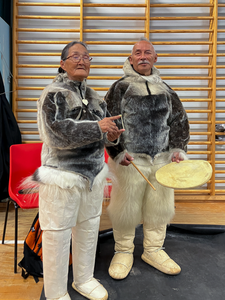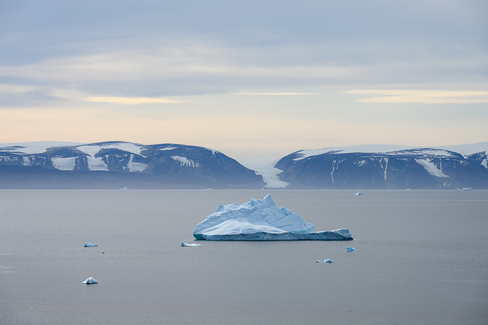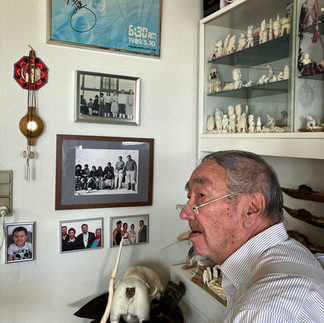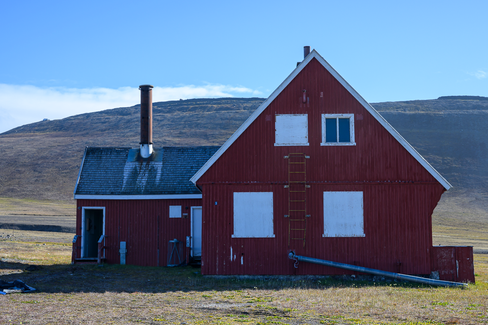Qaanaaq, Greenland: August 7, 2025
- Cecilia Clark

- Sep 18
- 4 min read
Updated: Sep 20

Continuing north along Greenland's west coast, we stopped for several hours at Qaanaaq. We were looking forward to this stop with interest as one of the community ambassadors, Aleq Peary, gave short lectures on the ship about life in Qaanaaq. Additionally, at this stop we had a chance to have tea in a private home (my choice) and also an opportunity to learn how to prepare skins and use them (Dan).
In the morning, a small group of the Qaanaaq community visited the ship to sing traditional and original songs. They sang an original song in Greenlandic to the tune of "Nearer My God to Thee." In an old Titanic movie that is the song passengers were singing when the ship went down.
Our first stop was at the large multi-purpose community center where the community had arranged displays that highlighted life in the far north of Greenland. At the camping display, a young man offered me a taste of Narwhal jerky. At first, it was just hard and chewy, but as my saliva softened it, my mouth became full of the blood released from the jerky. Probably won't do that again.
The hunting exhibit had a kayak, harpoon and bladder, tent, the hunter's clothing, and the camp. The big brown thing on the kayak is the bladder that is attached to the harpoon. The bladder insures that the animal will not sink and be lost at the bottom of the sea after it is hit. The bladder is a waterproof seal skin. There was also a square white cloth attached to small wooden runners. A young man pointed out a slit in the cloth and explained that that was where the hunter inserts his gun and quietly belly crawls over the ice to sneak up on the target animal.
The handsome couple is wearing clothing created by the woman. She is wearing a seal fur jacket (the seal's tail is left on), polar bear leggings, and thigh-high sealskin boots. His ensemble is much the same except that his boots are just knee high and his polar bear pants are visible above. He played the qilaat (the sealskin covered round drum) and they both sang. They have been married 40+ years.
Another woman showed how the fat is removed from the seal skin before it can be stretched on a frame and dried. She is using a very sharp ulu to remove the fat. That was one of the skills Dan learned in his workshop.
I enjoyed walking around colorful Qaanaaq. Qaanaaq is situated on a hill so a lot of exercise is involved if you live on one of the top streets. The view from the city is magnificent with icebergs and glacier topped mountains.
Walking along the shoreline, we found Dogland. While we were admiring the Greenlandic sled dogs a man came by with a wheelbarrow. The dogs reacted like crazy, and it was 5:00 pm which at our house is the universal feeding time for cats and dogs. He passed by but soon came back with a meat-filled wheelbarrow. He threw out one piece at a time to each dog until the meat was gone and the dogs were sated.
My tea was at the home of Hans Jensen (75 years old) and his wife. Hans enjoys photography and he told me he takes a photo every day. The view from his living room is of the ocean with the mountains beyond.
The large photo in the first photo below is an older photo with Han's wife and their children and nieces and nephews. They are all wearing polar bear pants and sealskin boots. The community dresses in their finest traditional outfits for the first day of school and other celebrations. These outfits are passed down as they are outgrown.
In the center photo below there is a small black and white photo of Hans, age 2, standing against a wall with his older siblings and parents. That photo was taken at Pituffik in 1953. All Greenlandic Inughuit were removed from Pituffik because the US and Denmark planned to build an air base on their land.
Pituffik (a Greenlandic word) was first settled 4,500 years ago by Paleo-Eskimo peoples migrating from the Canadian Arctic. Americans arrived at Pituffik in 1940 and the base (at that time, it was called Thule Air Base) was enlarged in 1950-1953 as a joint Cold War era project by the US and Denmark. In 2020 the base was transferred to the US Space Force, and in April 2023, Thule was renamed Pituffik Space Base.
In 1953 the Greenlandic Inughuit were removed and resettled 130 kilometres (81 miles) farther north in the Qaanaaq region of Greenland to the new town of Qaanaaq. The US and Danish governments did provide some monetary assistance to the community and to each family. Today we visited Qaanaaq, and yesterday we visited Pituffik but not the nearby Space Base.
The cemetery at Pituffik contains the ancestors of the people now living in Qaanaaq. They have permission to continue using the cemetery as their graveyard.

The cone-shapped mountain is Mount Dundas. The structures that are there now were probably associated with Thule Air Base when several thousand people worked there. Some may be summer homes. The Space Base (home of 821st Space Base Group) has about 150 persons assigned to it.
The ruin, a wood frame structure covered with sod, was possibly a hunting cabin.

Tomorrow: Continuing northward toward an abadoned settlement called Etah.




























































Comments